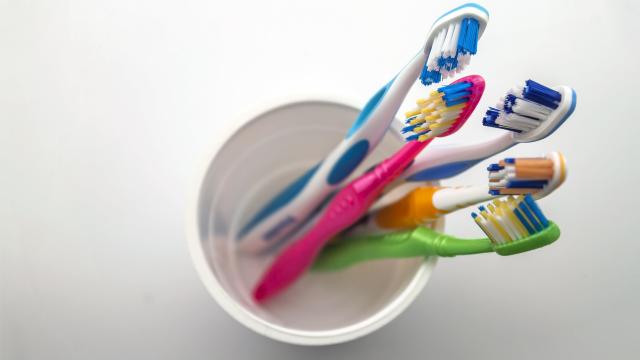There are two types of people in the world. The type who thoughtlessly store their toothbrushes out in the open, in the same bathroom that harbours a faecal-matter-spewing toilet (gross, right?), and the type who takes pains to cover their toothbrushes when not in use, and even periodically disinfect them in the dishwasher or with a fancy ultraviolet sterilizing device. Of the two groups, guess who is following the CDC and ADA guidelines for taking care of your toothbrush? Surprise, it’s the lazy folks.
But aren’t their toothbrushes covered in bacteria and other gross little microbes? They sure are. All toothbrushes are full of germs, and most of them come from our mouths. This review of studies on toothbrush contamination reports that all of them “found significant bacterial retention and survival on toothbrushes after use.”
Toothbrushes start out with germs on them (after all, they come from the factory clean, but not sterile) and quickly pick up whatever germs you have in your mouth. If you have any disease-causing microbes in your mouth (gum disease, cold sores) they will get on your toothbrush, and you’re not going to be able to fully remove them. And here’s a bonus fun fact: as toothbrushes get older, their surfaces wear down and they are able to harbour even more germs.
You’re not going to die from toothbrush germs
Let’s clear one thing up before we go any further: while the idea of germs on your toothbrush may gross you out, this isn’t actually a health hazard for most people. The CDC reports that people with bleeding disorders or who are immunosuppressed may need to find other ways of performing oral care, and if that’s you, talk to your doctor. For the rest of us: “The Centres for Disease Control and Prevention is unaware of any adverse health effects directly related to toothbrush use.”
Let your toothbrush dry out
The best way to deal with all these germs? According to the CDC and the American Dental Association, air drying is the key.
After you brush, rinse your toothbrush with tap water. This doesn’t remove bacteria, but it does get rid of any globs of toothpaste or other gunk that can interfere with the drying process. Place your toothbrush in a holder that allows it to sit upright and air dry. Drying the bacteria out is what keeps them from multiplying. Keeping used toothbrushes in a container or putting a cap over them is likely to encourage bacterial growth. The few germs you keep out are going to be outnumbered by the germs that are partying on the inside.
For more on proper toothbrush care:
- Don’t share toothbrushes; keep your bodily fluid residue to yourself.
- For the same reason, don’t let your toothbrush come into contact with anybody else’s toothbrush.
- Replace your toothbrush when it gets frayed, or about every three to four months. Toothbrushes clean your teeth best (and harbour fewer bacteria) when they’re in good condition.
If the thought of bacteria grosses you out so much that you feel you must do something about it, the ADA says you can soak your toothbrush in Listerine or in 3% hydrogen peroxide (the stuff you get in the brown bottle at the drugstore). This won’t kill all the bacteria, but it may reduce levels by 85%. (Now, 85% of a bajillion is still a bajillion, but maybe that makes you feel better.)
Don’t put your toothbrush into the dishwasher or the microwave; this might kill bacteria, but it will also damage your toothbrush. The experts seem to be split on ultraviolet (UV) sterilizers. The CDC says they “may damage” toothbrushes; the ADA acknowledges that they exist but doesn’t make a recommendation for or against them.
So is there poop on my toothbrush or not?
So what about those toilet plumes, anyway? It’s true that toilets can send droplets into the air, with some of those evaporating into aerosols that can float around the room and possibly eventually settle down onto your toothbrush or other objects.
But there’s no research that directly connects toilet-derived aerosols to toothbrushes making people sick. Instead, we have studies like this dissertation that found traces of potentially faecal-derived bacteria on 60% of toothbrushes stored in communal bathrooms (the average bathroom was shared by nine people). But there was no control group in that study; this wasn’t a comparison of toothbrushes stored in bathrooms versus toothbrushes stored elsewhere, it was just a survey of toothbrushes. (It also found that the bacteria were more common on toothbrushes that were rinsed in mouthwash, suggesting that a mouthwash soak may not be the best way of alleviating your germophobia.)
On the other hand, a microbiome project sequenced the microbes found on toothbrushes from volunteers across the country and weren’t able to find any conclusive evidence that toothbrushes are being colonised by faecal bacteria. (Earlier studies, including the dissertation, used methods that couldn’t tell for sure whether the germs came from poop, just that they appeared to be in the same sorts of families as common poop germs.) “It’s reasonably unlikely to find bacteria from our poop on your toothbrush,” one of the authors told Gizmodo.
Whether there are poop germs on your toothbrush or not, we’ve already established that it’s better to let germs dry out than to incubate them in a closed container. You could store your toothbrush in a different room, if you prefer, but watch out for whatever stealthy sources of germs are in that room.

Leave a Reply
You must be logged in to post a comment.